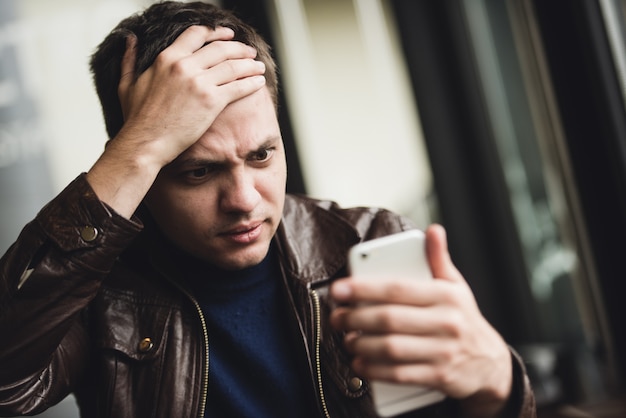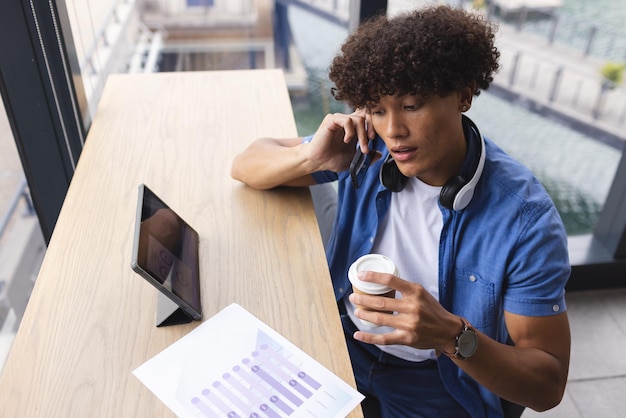Smartphone Addiction: Is It Impacting Your Mental Health and Wallet?

Smartphone addiction can negatively impact mental health and financial well-being, leading to increased stress, anxiety, and potential monetary losses due to impulsive purchases or neglecting responsibilities.
Are you constantly reaching for your smartphone? While smartphones offer convenience and connection, excessive use can have hidden costs. Let’s explore if your smartphone addiction is costing you more than just money and understand the impact on your mental health.
Is Your Smartphone Addiction Affecting Your Mental Well-being?
Smartphone addiction, also known as problematic smartphone use, is a behavioral addiction characterized by excessive or compulsive use of smartphones. It has become a growing concern in recent years, especially with the increasing prevalence of smartphones in our daily lives. But is it really affecting our minds?
The answer is yes. Several studies have shown a significant correlation between smartphone addiction and various mental health issues. Here’s what you need to know.

The Link Between Smartphone Addiction and Anxiety
One of the most common mental health issues linked to smartphone addiction is anxiety. Constant notifications, the need to stay connected, and the fear of missing out (FOMO) can trigger anxiety and increase stress levels. Let’s dive deeper.
- Constant Notifications: The barrage of notifications from social media, emails, and messaging apps keeps the brain in a state of hyper-arousal, leading to chronic stress and anxiety.
- Fear of Missing Out (FOMO): The constant exposure to others’ seemingly perfect lives on social media can fuel feelings of inadequacy and the fear of missing out on experiences, further exacerbating anxiety.
- Cyberbullying: For many, smartphones are the gateway to online interactions, which unfortunately includes exposure to cyberbullying, a significant contributor to anxiety and depression.
The Impact of Smartphone Addiction on Depression
Depression is another mental health condition often associated with smartphone addiction. Excessive smartphone use can lead to social isolation, reduced physical activity, and sleep disturbances, all of which can contribute to depressive symptoms. Consider these points:
Spending too much time on smartphones often involves sedentary behavior, diminishing physical activity. Low physical activity is a known factor in the onset and worsening of depression.
Furthermore, artificial light exposure especially close to bedtime delays the release of melatonin, a hormone that promotes sleepiness. Disrupted sleep patterns are closely linked to mood disorders, including depression.
In conclusion, the connection between smartphone addiction and both anxiety and depression highlights the importance of mindful technology use. It’s about balancing digital engagement with real-world interactions and self-care activities to protect your mental wellbeing.
How Smartphone Addiction Impacts Your Sleep
Beyond mental health, your sleep is another critical area affected by smartphone addiction. Sleep deprivation can exacerbate existing mental health issues and lead to a host of other health problems. Here’s how smartphones disrupt your sleep.
The impact on sleep is often underestimated but has far-reaching effects on physical and mental well-being. Managing screen time, especially before bed, is essential in maintaining your sleep.
Blue Light Exposure and Sleep Disruption
Smartphones emit blue light, which can suppress the production of melatonin, a hormone that regulates sleep. Using smartphones close to bedtime can delay sleep onset and reduce sleep quality. Limiting screen time, and using blue light filters are just two of the options to help with this issue.
- Using Devices Late: Late-night scrolling and video watching on phones can make it harder to fall asleep.
- Sleep Quality: Reduced sleep because of late-night phone use has been linked to reduced cognitive functions.
- Difficulty Waking: Regular sleep disruptions can cause difficulty waking up in the mornings.
It’s clear that managing smartphone use is crucial for maintaining healthy sleep patterns. By minimizing screen time before bed, utilizing blue light filters, and establishing a consistent sleep schedule, individuals can mitigate the adverse effects of smartphone addiction on their sleep quality and overall well-being.
In conclusion, consider setting a ‘digital curfew’ for yourself. This means avoiding screens for at least an hour or two before bed thereby promoting a more restful sleep and better overall health.
The Financial Burden of Smartphone Addiction
Beyond the mental and physical health implications, smartphone addiction can also carry a significant financial burden. Impulsive purchases, data overages, and the constant need for the latest gadgets can strain your budget. Think before you click!
When considering the financial costs associated with smartphone addiction, it’s important to recognize both direct expenses and indirect costs linked to decreased productivity and professional neglect.

Impulsive Purchases and Overspending
The ease of online shopping via smartphones can lead to impulsive purchases and overspending. Addictive smartphone users may find themselves constantly buying things they don’t need. The convenience of mobile shopping is a slippery slope.
Easy access to online shopping, often driven by targeted ads based on browsing history, contributes significantly to the issue of impulsive buying. These scenarios create a perfect storm for overspending, leading to financial strain and debt accumulation.
Data Overages and Unnecessary Apps
Excessive smartphone use can lead to data overages and the purchase of unnecessary apps, adding to your monthly expenses. How many apps do you actually use every day?
Smartphone addiction also often involves downloading numerous apps, many of which are not entirely free. In fact, people subscribe to a bunch of digital services directly with their smartphones.
Therefore, being attentive to data use, frequently managing and deleting unused apps, and subscribing only to essential services can alleviate some of the economic burden tied to smartphone addiction.
Strategies for Breaking Free from Smartphone Addiction
Breaking free from smartphone addiction requires a conscious effort and a commitment to change. There are several strategies you can implement to regain control of your smartphone use and improve your overall well-being. What can you start doing today?
Effectively curbing dependency on smartphones requires a combination of self-awareness, practical strategies, and the support of others. By systematically addressing the underlying causes and triggers associated with smartphone overuse, you can establish healthier habits and a more balanced lifestyle.
Set Time Limits and Use Apps to Monitor Usage
One of the first steps in breaking free from smartphone addiction is to set time limits for specific apps and monitor your usage. Many smartphones have built-in features that allow you to track your screen time and set daily limits. Try it, you may be surprised.
- Built-in Features: These native tools offer comprehensive insights into app usage, enabling setting daily or weekly limits to reduce dependence gradually.
- Third-Party Apps: There are many reliable and secure tracker apps available in the marketplace.
- Habitual Changes: Use these functions to monitor smartphone use.
Beyond just monitoring, it’s important to actively use the data these tools provide to make informed decisions about your usage. Setting realistic goals, rewarding progress, and making gradual changes can lead to long-term improvements.
Create Phone-Free Zones and Times
Designate specific areas and times as phone-free zones. This could include your bedroomDuring meals, social gatherings, any place where you would normally talk to someone. It’s OK to leave your phone in another room.
Doing this helps create physical and psychological barriers between you and your smartphone, thus encouraging you to engage more fully in real-life experiences and interactions. The key is to make these boundaries clear and consistent.
In conclusion, breaking free from smartphone addiction involves a combination of strategic planning and consistent execution. By setting time limits, establishing phone-free zones, and engaging in offline activities, individuals can regain control over their smartphone use and cultivate a healthier, more balanced lifestyle.
The Role of Digital Detox in Overcoming Addiction
A digital detox involves intentionally disconnecting from digital devices for a set period. This can help you break free from the constant stimulation of smartphones and rediscover the joys of offline activities. It is a way to “reset” your brain.
Digital detoxes serve as a necessary tool for recalibrating one’s relationship with technology, allowing individuals to assess the benefits of digital connectivity and find more balance between their digital and physical worlds.
Planning Your Digital Detox
Before embarking on a digital detox, it’s important to plan ahead. Choose a time when you can comfortably disconnect from your devices, such as a weekend or vacation. What if you started with just one day?
- Identify Triggers: Figure out the reasons you are always on the phone. Is it boredom? Is it for work purposes? Is it a way to avoid conversations?
- Set Boundaries: Let people know when you will turn off your phone, and during what hours it will be off.
- Find Alternatives: Plan activities that will hold your interest such as a nature walk, art activities, or even writing a book.
Keep in mind that the goal is to foster better habits, not to completely abstain forever. Regular digital detoxes can help maintain a healthy relationship with technology and prevent future relapses into addiction.
Reconnecting Mindfully After a Detox
After your digital detox, it’s important to reconnect mindfully with your devices. Avoid immediately falling back into old habits. What did you learn during your time away from your devices and the internet?
The lessons learned during a detox period can guide you in restructuring your digital engagement to align more closely with your personal goals and values. Establishing a new relationship with your phone and technology is necessary to move forward.
To summarize, digital detoxes provide a powerful means of resetting one’s dependence on technology. By facilitating self-reflection, promoting intentional device usage, and supporting the establishment of healthier habits, digital detoxes can play a vital role in overcoming smartphone addiction and cultivating a lifestyle that prioritizes overall well-being.
Seeking Professional Help for Severe Cases
In severe cases of smartphone addiction, seeking professional help may be necessary. Therapists and counselors can provide guidance and support to help you break free from your addiction and address any underlying mental health issues if nothing else will work for you.
Recognizing when professional help is needed and proactively pursuing the right support are essential steps in improving mental health with professional service, by using specialized therapies and strategies to foster behavioral changes.
Therapy and Counseling Options
Cognitive-behavioral therapy (CBT) is one of the most effective treatments for addiction, including smartphone addiction. CBT helps you identify and change negative thought patterns and behaviors associated with your addiction. This gives the person a chance to focus and to improve.
Support groups are also available so that users and addicts can discuss and relate to the issues and reasons behind their habits.
- Peer Groups: Joining support groups can improve a person’s chance of getting better.
- Specialized Therapy: Working with therapists trained in addiction can help people change their lives.
- Medication: In some severe cases that are linked with depression or other mental illness, your psychiatrist may consider medication to help with your overall wellness.
To conclude, professional support offers targeted, evidence-based strategies that go beyond self-help techniques, addressing the complex psychological and behavioral aspects of smartphone addiction.
| Key Point | Brief Description |
|---|---|
| 📱 Mental Health | Addiction links to anxiety, depression, and sleep problems. |
| 💸 Financial Costs | Impulsive buys and data overages can drain your wallet. |
| ⏰ Time Management | Set limits and create phone-free times to regain control. |
| 🔄 Digital Detox | Disconnect, plan, and reconnect mindfully for a healthier balance. |
FAQ
▼
Signs include excessive use, anxiety when unable to use your phone, neglecting responsibilities, and feeling the need to constantly check for updates or notifications.
▼
Set time limits per day. You can also try disabling non-essential notifications, and find hobbies that do not require looking at your phone for long periods of time.
▼
You can try painting, drawing, writing, a sport, hanging out with friends (without phones!), knitting, reading, and anything that does not utilize your phone.
▼
Blue light suppresses melatonin production, which regulates sleep. Using smartphones or similar devices for hours before bed can delay sleep onset and reduce sleep quality.
▼
Please seek professional help for your mental and digital wellbeing if you are unable to control your phone use or if it is severely affecting your relationships or life.
Conclusion
Smartphone addiction is a serious issue with far-reaching consequences for your mental health, financial stability, and overall well-being. By recognizing the signs of addiction and implementing strategies to break free, you can regain control of your smartphone use and live a more balanced and fulfilling life.